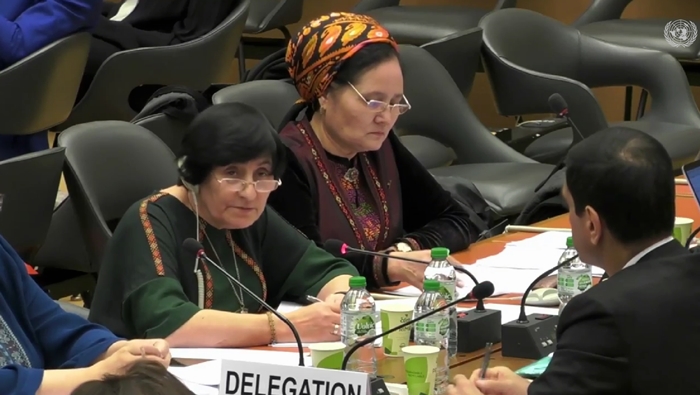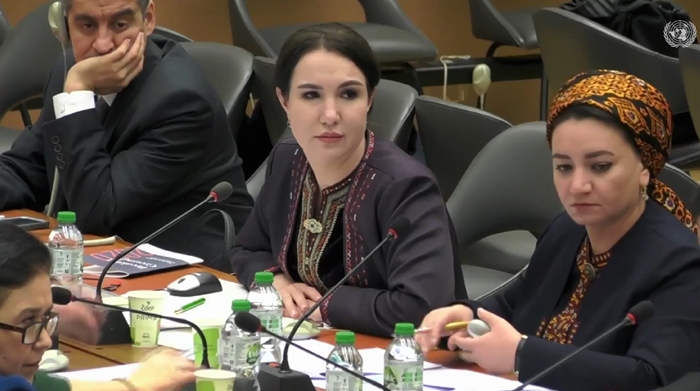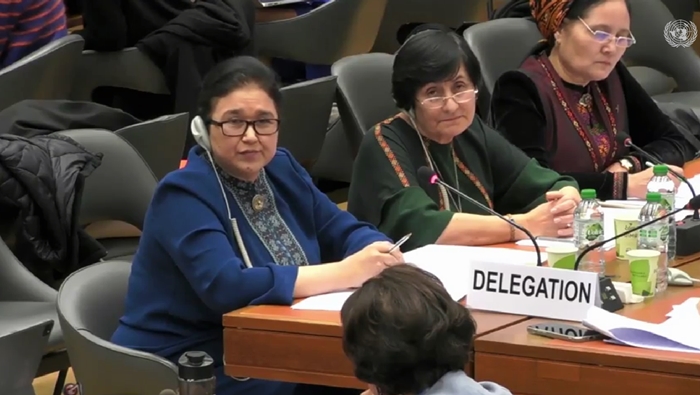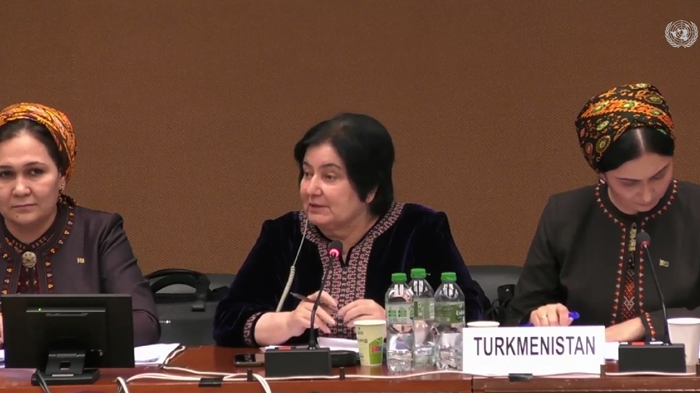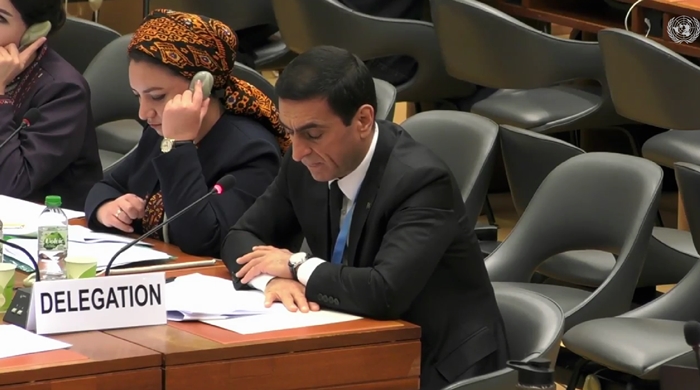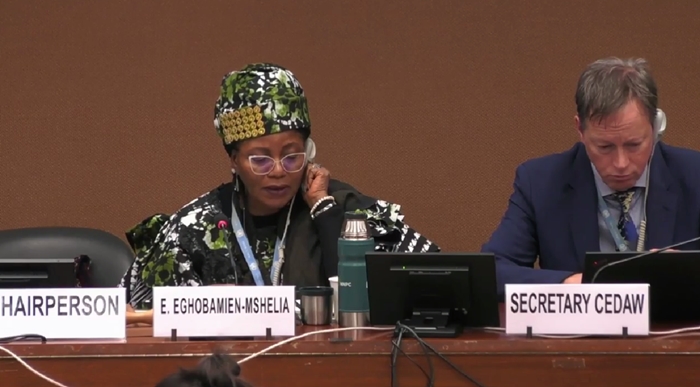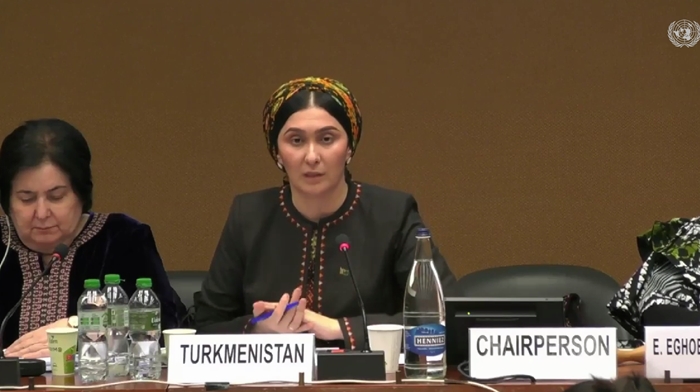 On 2 February 2024, the UN Committee on the Elimination of Discrimination against Women considered Turkmenistan’s sixth periodic report on the implementation of the Convention on the Elimination of All Forms of Discrimination against Women.
On 2 February 2024, the UN Committee on the Elimination of Discrimination against Women considered Turkmenistan’s sixth periodic report on the implementation of the Convention on the Elimination of All Forms of Discrimination against Women.
The sixth periodic report of Turkmenistan (CEDAW/C/TKM/6) is available here: https://tbinternet.ohchr.org/_layouts/15/treatybodyexternal/Download.aspx?symbolno=CEDAW/C/TKM/6&Lang=en
The report was presented by Deputy Minister of Foreign Affairs of Turkmenistan and head of the delegation Myakhri Byashimova.
An summary of the presentation of the Turkmen delegation, produced by the United Nations Information Service in Geneva, was published on the official website of the Office of the United Nations High Commissioner for Human Rights.
Video of the the presentation of the Turkmen delegation: https://webtv.un.org/en/asset/k11/k11bl1zvmf
Here are some key facts and statistical indicators related to the situation of women in Turkmenistan and efforts to ensure gender equality in the country (based of the presentation by Myakhri Byashimova and the delegation’s answers to the Committee’s experts’ questions):
National Action plan: The National Action Plan on Gender Equality 2021-2025 includes measures promoting gender equality, gender-responsive health care, equal access to education, economic empowerment of women and girls, and countering gender-based violence.
Monitoring mechanism: An inter-agency commission had been set up to coordinate and monitor the implementation of the National Action Plan on Gender Equality, including in rural areas. The commission had working groups on combatting trafficking and on monitoring domestic violence, which made recommendations for implementing gender policies.
Legislation to combat domestic violence: On efforts to address domestic violence, the delegation said that the Turkmen Parliament was working to adopt the law on domestic violence developed by the United Nations Population Fund.
Support of the victims of domestic violence: Turkmenistan and non-governmental organizations provided support to victims of domestic violence. Th two hotlines have been opened for reporting domestic violence. Training for journalists have been held to prevent stereotyping of women in the media, and for social workers to provide support to victims of violence.
Combating human trafficking: Turkmenistan is actively working with the International Labour Organization in monitoring cotton harvests and discussing future actions to prevent exploitation. More than 140 staff of the Interior Ministry had participated in training seminars aimed at combatting trafficking. The Government worked to identify victims of trafficking and provide them with assistance. Many public bodies held information campaigns aiming to prevent trafficking. Free legal assistance and State support were provided to victims of trafficking.
Women in parliament and power bodies: Women are well represented in the Parliament of Turkmenistan. In the 2023 elections, 125 deputies of the Parliament were elected, 32 of whom were women. A woman had been elected Speaker of the Parliament for the third time in a row. Women are represented in all political parties registered in Turkmenistan and made up 28 per cent of local self-government bodies; 26.4 per cent of employees of the Ministry of Foreign Affairs were women, of which 21.5 per cent were women diplomats. Since 2010, the Turkmenistan had been working to increase the representation of women in the foreign service.
Women in business: Women were also active in the business sphere; today 22.4 % of entrepreneurs were women, and women had strong representation in leadership positions in the private sector. The share of women amongst entrepreneurs had increased to around 35%. Credit loans are provided on equal conditions regardless of the sex of the applicant. The volume of loans provided to female entrepreneurs had risen by a factor of four in recent years. The number of women farmers had increased by around 13 % in 2023.
Women in workforce structure: The share of women in the workforce had increased from 45.8 % in 2019 to more than 48 % currently. The proportion of women in managerial positions was 22.4 per cent. The Labour Code guarantees additional benefits to working women with young children and children with disabilities. Pensions and State benefits, including disability benefits, are increased annually by decrees of the President. 56% of recipients of disability benefits were women.
Adaptation to labor market: The Government had adopted a programme to adapt youth to the labour market. Women only represented 30 % of participants in the programme, as it targeted sectors that attracted more men than women. A greater number of women were entering the oil and gas industries.
Salary: The wage gap between men and women was 12 per cent overall, but in education, health and social service work, women make up 70 % of the workforce, and were paid 6.8 % more than men.
Survey: In 2020, a sample survey “Health and Status of Women in the Family” was conducted, covering key topics related to violence against women. A roadmap for the implementation of the survey’s recommendations for 2022 to 2025 had been developed.
Tackling with statelessness: The Government was taking steps to ensure the rights of refugees and stateless persons. Over the past four years, 1,860 residence permits had been issued, of which more than 80 % were issued to women, and 8,068 persons were granted citizenship, of which more than 55% were women.
Awareness raising: Gender issues had been included in the Academy of Civil Service training courses for middle managers. The Supreme Court has an Information Centre that conducted seminars for judges that addressed gender equality.
Women in Education sector: The vocational training of women was increasingly taking on a scientific and technical bias. The share of girls studying in higher vocational education institutions had increased significantly to 45.4 % in the 2023-2024 academic year, and to 65.7% in secondary vocational education institutions. 33% of students studying in foreign countries are girls. 67% of teachers in general schools were women. In higher education facilities in 2023, 44 % of students and 48 % of teachers were women. Access to education was a national priority. The State had a centre for young scientists that provided education to girls.
Maternal and reproductive health: The Government had made maternal and reproductive health a priority. In 2021, the National Strategy “Healthy Mother – Healthy Child – Healthy Future” was approved to protect maternal and child health in Turkmenistan for 2021 to 2025. The maternal mortality rate per 100,000 live births had decreased from 3.0 in 2015 to 1.7 in 2022. To improve the health of expectant mothers, the country had introduced a tool to assess the quality of family planning services and identified risk groups. For the period from 2015 to 2022, there was a positive trend in the decline in the birth rate among adolescent girls aged 15 to 19 years, from 24.5 births per 1,000 adolescent girls in 2019 to 22.9 births in 2022.
All women in Turkmenistan were able to access abortions up to five weeks of pregnancy. After five weeks, abortions were risky, so requests were assessed based on individual circumstances. Abortions were possible up to 22 weeks of pregnancy if malformation of the foetus was found.
Medical screenings are provided free of charge to pregnant women. Hospitals have productive health centres that provided at-risk women and girls with free contraception and medication.
Tackling discrimination: Violence and discrimination against lesbian, bisexual, transgender and intersex women are prohibited and punished.
Polygamy: Turkmenistan did not have a major problem with polygamy. Polygamy was illegal and men who attempted to marry more than one wife are criminalised. An amendment to the Family Code had previously been made to ensure gender equality in divorce proceedings.
Marriage: Under the Family Code, the age of marriage was 18. Children of 17 years of age could marry only when they had special permission from authorities. Only 0.04 % of marriages were with girls aged under 18. Authorities investigate child marriages and bring perpetrators to account. Turkmenistan conducts awareness raising campaigns aiming to prevent early marriages across the country, in collaboration with non-governmental organizations. Traditions are not part of legislation in Turkmenistan.
***
The delegation of Turkmenistan consisted of the Permanent Representative of Turkmenistan to the United Nations Office at Geneva, and representatives of the State Statistics Committee; National Trade Unions of Turkmenistan; Women’s Union of Turkmenistan; Committee for Protection of Human Rights and Freedoms of the Mejlis; Ministry of Education; Ministry of Labour and Social Protection of the Population; Institute of State, Law and Democracy; Ministry of Health and Medical Industry; Ministry of Internal Affairs; and the Permanent Mission of Turkmenistan to the United Nations Office at Geneva.
The Committee on the Elimination of Discrimination against Women’s eighty-seventh session is being held from 29 January to 16 February. All documents relating to the Committee’s work, including reports submitted by States parties, can be found on the session’s webpage. Meeting summary releases can be found here. The webcast of the Committee’s public meetings can be accessed via the UN Web TV webpage. ///nCa, 5 February 2024
